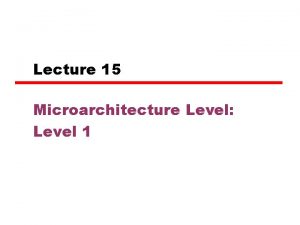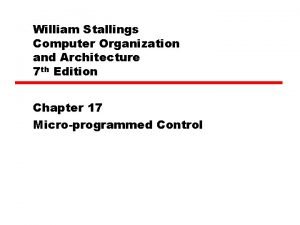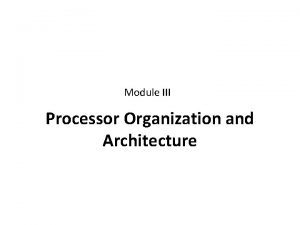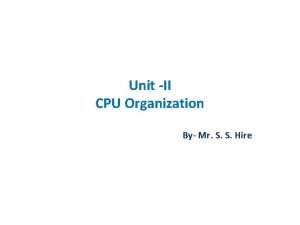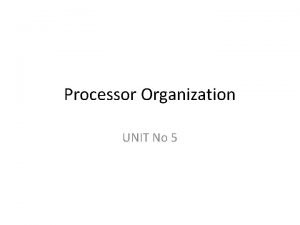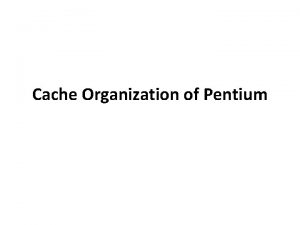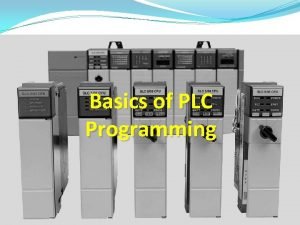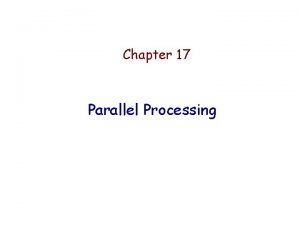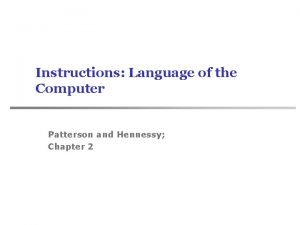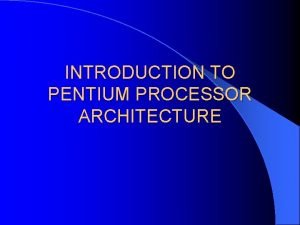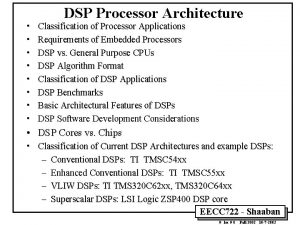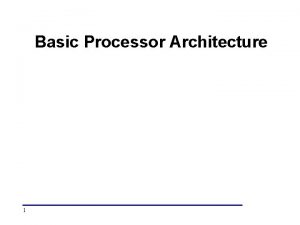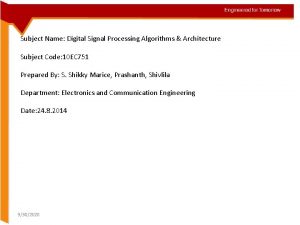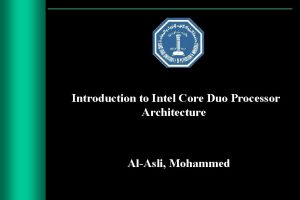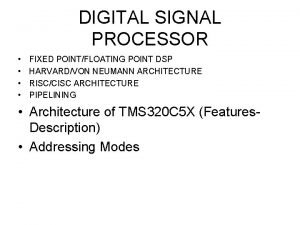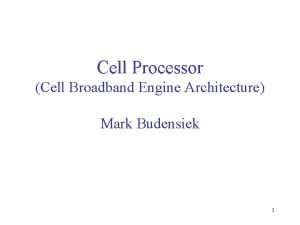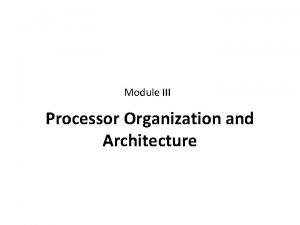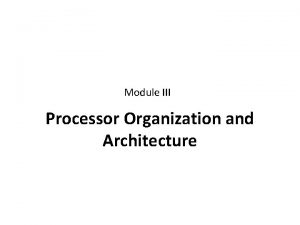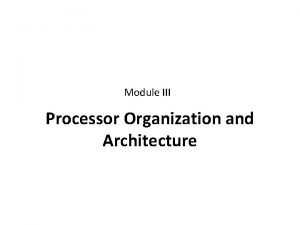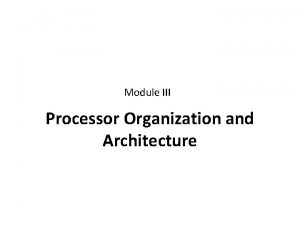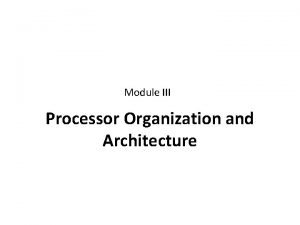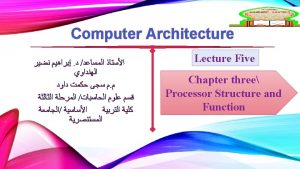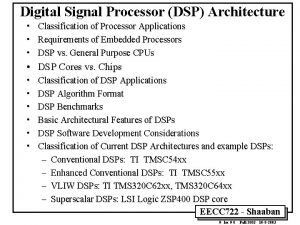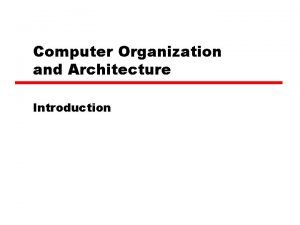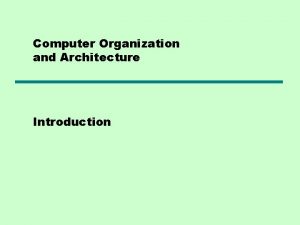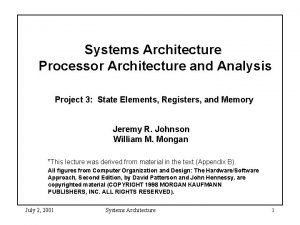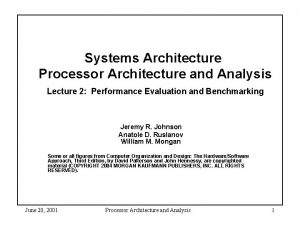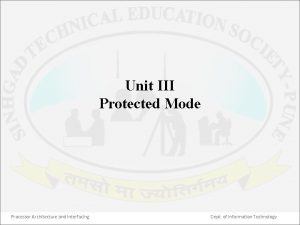Module III Processor Organization and Architecture Microinstruction Execution



















- Slides: 19

Module III Processor Organization and Architecture

Microinstruction Execution

Microinstruction Encoding • Microinstruction Encoding are of two types – Vertical – Horizontal

Nano-programming • In this method, microinstructions does not generate control signals directly but uses a second control memory called Nano Control Memory (NCM) • There are two levels of control memory: – higher level Micro Control Memory & – lower level NCM that stores nano-instructions


Nano-programming • Suppose there are n = 2048 micro-ops each of 41 bits wide, • The memory required for single control ROM is 2048 x 41 =83, 968 bits

Nano-programming • Suppose there are 100 unique control words in ROM. • These 100 words can be uniquely saved in nano control ROM saving space as shown:

Nano-programming • Advantage: – Reduces total size of required control memory – Greater design flexibility • Disadvantage: – Less speed due to two level memory

Classification based on instruction sets • Complex Instruction Set Computers • Reduced Instruction Set Computers

Complex Instruction Set Computers • CISC processor mostly uses a unified cache for both data and instructions and shares the same path • They mostly use microprogrammed CU and hence control memory is required and it slows down the execution

CISC Architecture

CISC Characteristics • It tries to simplify the compilation and improve the overall computer performance. – CISC architecture attempt to provide a single machine instruction for every statement in a highlevel language. • It incorporates variable-length instruction formats. – Packing variable instruction formats in memory requires special decoding circuits.

CISC Characteristics • Instructions manipulate operands in memory • Uses a variety of addressing modes—from 5 to 20 • Uses a large number of instructions—from 100 to 250 • Includes specialized instructions which are used infrequently • Examples : Motorola 68000 family, Intel x 86 CPUs-Pentium

Reduced Instruction Set Computers • It uses separate instruction and data caches and their access paths are different • It uses hardwired control unit and hence faster execution.

RISC Architecture

RISC Characteristics • Uses a small set of instructions with register-toregister operations and simple load and store operations for memory. • Uses only a few addressing modes • Follows a simple instruction format – instruction length is fixed and aligned on word boundaries. • Instructions are easy to decode. • Hardwired control makes faster execution

RISC Characteristics • Execute one instruction per clock cycle – Includes pipelining – Load or store may require two clock cycles. • Uses a large number of registers – overlapped register windows speed-up procedure call and return. – Thus register-to-memory operations is minimized • Examples : SPARC, Alpha, . . .

RISC vs CISC RISC CISC • Contains simple instructions of one clock cycle • Contains complex instructions taking more than one clock cycle • Most of the instructions may refer memory • Micro-programmed Control Unit • Variable Format Instructions • Very few instructions refer to memory • Hardwired Control Unit • Fixed Format Instructions

RISC vs CISC RISC • • Few Instructions Few Addressing Modes Many Registers Complexity is in compiler • Faster clock rates • Reduces the cycles per instruction at the cost of the number of instructions per program. CISC Many Instructions Many Addressing Modes Few Registers Complexity is in microprogram • Slower clock rates • Minimize the number of instructions per program sacrificing the number of cycles per instruction. • •
 Microinstruction example
Microinstruction example Address sequencing in computer architecture
Address sequencing in computer architecture Microinstruction in computer architecture
Microinstruction in computer architecture Selection of address for control memory
Selection of address for control memory Recruiting and retaining capable employees
Recruiting and retaining capable employees Hamlet act iii scene ii
Hamlet act iii scene ii Processor organization
Processor organization Processor organization
Processor organization The pentium has kb instruction and kb data cache.
The pentium has kb instruction and kb data cache. Memory in plc
Memory in plc Processor examples in computer organization
Processor examples in computer organization Processor organization
Processor organization Processor organization
Processor organization Intel pentium processor architecture
Intel pentium processor architecture Dsp architecture block diagram
Dsp architecture block diagram Basic processor architecture
Basic processor architecture Digital signal processor architecture
Digital signal processor architecture Intel core processor architecture
Intel core processor architecture Digital signal processor architecture
Digital signal processor architecture Cell processor architecture
Cell processor architecture
